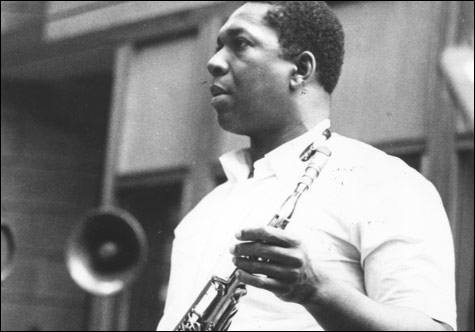
LOVE SUPREME: For Ratliff and Brown, Coltrane’s sound has a moral dimension that supersedes technique. |
Here’s what’s happening and where to find it in the John Coltrane Memorial Concert week; more details at www.jcmc.neu.edu. AARDVARK JAZZ ORCHESTRA | “Coltrane Facets,” with guest Jerry Leake, tablas and percussion | Broad Institute of MIT and Harvard | 7 Cambridge Center, Kendall Square, Cambridge | September 16 at 7:30 pm | 617.452.3205 “NEC TRIBUTE TO THE 30 YEAR JCMC LEGACY” | Featuring Your Neighborhood Saxophone Quartet, Rakalam Bob Moses, Cecil McBee, George Garzone, and Jerry Bergonzi | New England Conservatory, Brown Hall, 30 Gainsborough St, Boston | September 17 at 8 pm | 617.585.1122 “THE SOUL OF COLTRANE” | Discussion with Bill Bamfield and Armsted Christian, performances by students and faculty | Berklee College of Music, David Friend Recital Hall, Genko Uchida Building, 921 Boylston St, Boston | September 18 at 7- 9 pm | 617.266.1400 x2957 “HISTORY OF THE JOHN COLTRANE MEMORIAL CONCERT” | Northeastern University, John D. O’Bryant African American Institute, 40 Leon St, Boston | September 19 | 11:45 am–1:15 pm | 617.373.3143 “LISTENING TO TRANE” | Panel discussion with Ingrid Monson | Harvard University Music Building, Classroom 2, North Yard, Cambridge | September 20: 7-9 pm | 617.496.6013 BILL PIERCE QUARTET WITH MULGREW MILLER | Fundraiser for JCMC Educational Outreach Program | Northeastern University, Blackman Theatre, 360 Huntington Ave, Boston | September 21 at 8 pm | 617.373.4700 JOHN COLTRANE MEMORIAL ENSEMBLE FEATURING RAVI COLTRANE QUARTET AND AMIRI BARAKA | Blackman Theatre | September 22 at 7:30 pm | 617.373.4700 |
John Coltrane died 40 years ago this past July at the age of 40 of liver cancer. His influence on jazz is incalculable. Some have argued that there might be no college-level jazz education if it weren’t for Coltrane — his methodology, his obsession with theory, provided a way into his language, and as a professional musician Coltrane was a model of sobriety and serious dedication to craft, a man who cleaned up his act, worked hard, and progressed from journeyman-like proficiency to mastery. But there’s something else, too. In his new book Coltrane: The Story of a Sound (Farrar, Straus and Giroux), New York Times critic Ben Ratliff reports on seeing 15 young saxophonists at the Thelonious Monk Institute’s International Saxophone Competition a few years ago. “Coltrane was everywhere in their playing that weekend,” Ratliff writes. “If these saxophonists wanted to imply sophistication, depth, stamina, fervor, tenderness, they used Coltrane’s language.”
Ratliff is after more than Coltrane’s technique — he’s after the elements that transcend technique, and even jazz, elements that have left Coltrane the dominant figure — still — on the jazz landscape. That’s why his book is the story of a “sound”: the totality of Coltrane’s expression, not just his playing or his compositions, but his craft and his methodology, his ensemble conception, and finally his spirituality.
This idea of Coltrane’s sound — including that spiritual element — isn’t lost on Leonard Brown, a 61-year-old saxophonist and professor of Music and African-American Studies at Northeastern, where he teaches a course on Coltrane. In July 1977, he and a group of fellow musicians who regularly convened at the Friends of Great Black Music Loft in Chinatown created the John Coltrane Memorial Concert, which celebrates its 30th anniversary next week. (See sidebar.) Brown was born and raised in segregated Lexington, Kentucky, and from the beginning of his career he identified jazz as part of the civil-rights struggle, as a force for social change. His ’60s outfit in Lexington was the Afro-American Ensemble, and its musical and social agendas were conjoined. When he got to Boston, he worked on desegregation in South Boston’s schools, introducing multicultural arts programs.
Brown is in the midst of editing a book for Oxford University Press, John Coltrane and Black America’s Quest for Freedom: Spirituality and the Music. Sitting in his office, I ask him about Coltrane’s continuing influence, and before I can even prompt him, he’s on the same page with Ratliff. “I see a real parallel between John and Marian Anderson, because ultimately it’s the sound. What touches us is the sound. The reason I’m teaching the course on Coltrane — like I told my kids in class today, ‘Why are we in this room at this time? It’s Trane’s sound.’ ”
What gives Coltrane’s sound its moral weight for Brown is its rootedness in black culture. “He grew up in these black churches in North Carolina during segregation — you can believe that by the time he was five he knew where he had to be so he didn’t have to worry about being lynched. It went with the territory! I know that from my own experience! Who knows what he heard in those black churches? But I guarantee he heard the real deal!”